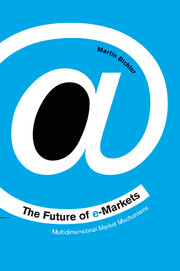Book contents
- Frontmatter
- Contents
- List of figures
- List of tables
- Preface
- Acknowledgments
- 1 Electronic Commerce and Electronic Marketplaces
- 2 Internet Marketplaces – A Technical Perspective
- 3 The Diffculty of Setting Prices
- 4 Methods for the Analyses and Design of Electronic Markets
- 5 Automated Negotiations – A Survey of State-of-the-Art Practices
- 6 Experimental Analysis of Multi-Attribute Auctions
- 7 Economic Models of Multi-Attribute Auctions
- 8 Conclusions and Perspectives
- Appendix: Utility Theory and Decision Analysis Techniques
- References
- Index
6 - Experimental Analysis of Multi-Attribute Auctions
Published online by Cambridge University Press: 22 September 2009
- Frontmatter
- Contents
- List of figures
- List of tables
- Preface
- Acknowledgments
- 1 Electronic Commerce and Electronic Marketplaces
- 2 Internet Marketplaces – A Technical Perspective
- 3 The Diffculty of Setting Prices
- 4 Methods for the Analyses and Design of Electronic Markets
- 5 Automated Negotiations – A Survey of State-of-the-Art Practices
- 6 Experimental Analysis of Multi-Attribute Auctions
- 7 Economic Models of Multi-Attribute Auctions
- 8 Conclusions and Perspectives
- Appendix: Utility Theory and Decision Analysis Techniques
- References
- Index
Summary
We've suddenly made the interaction cost so cheap, there's no pragmatic reason not to have competitive bidding on everything.
(Stuart I. Feldman, IBM Institute for Advanced Commerce)Subsection 5.2.2 introduced negotiation support systems, which are used to support bilateral negotiations on multiple attributes. This section introduces multi-attribute auctions, a generalization of reverse auctions. Multiattribute (reverse) auctions combine the advantages of auctions, such as high efficiency and speed of convergence, and permit negotiation on multiple attributes with multiple suppliers in a procurement situation.
Multi-Attribute Procurement Negotiations
Several authors have analyzed tenders and reverse auctions (Dasgupta and Spulber, 1989; Laffont and Tirole, 1993). Previous game-theoretical models of reverse auctions have generally assumed that the qualitative attributes are fixed prior to competitive source selection – hence, bidding competition is restricted to the price dimension. While such an approach may be appropriate for auctions of homogeneous goods, this assumption does not necessarily apply to most procurement situations.
In reverse auctions, bidders often provide very different kinds of goods and services in their bids. An example is the procurement of large food retailers (Bichler, Kaukal and Segev, 1999). The suppliers in the market consist of large companies as well as a large number of small and mediumsized enterprises (SMEs) such as bakeries and breweries. The buyers are a small number of large food retailers who aggregate the demand and distribute it to the consumer.
- Type
- Chapter
- Information
- The Future of e-MarketsMultidimensional Market Mechanisms, pp. 139 - 174Publisher: Cambridge University PressPrint publication year: 2001

